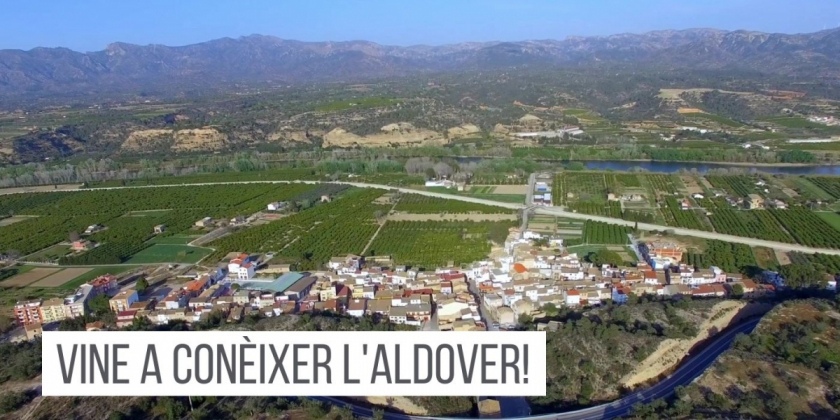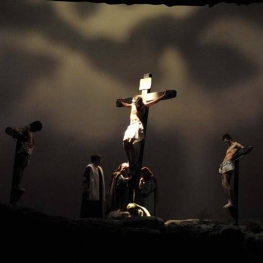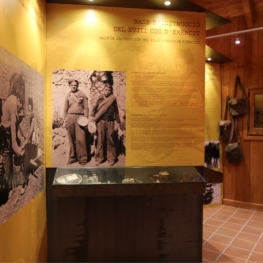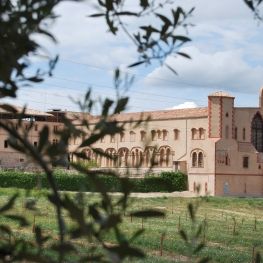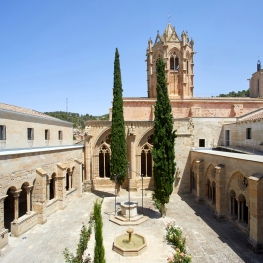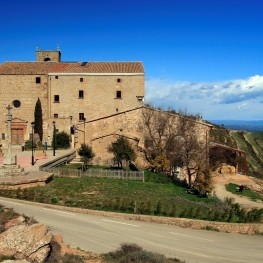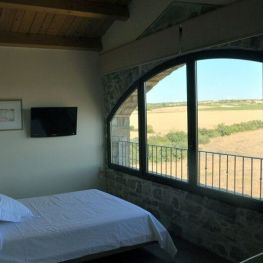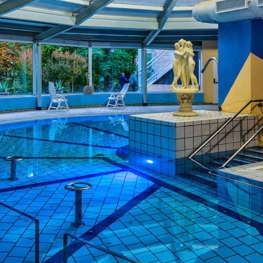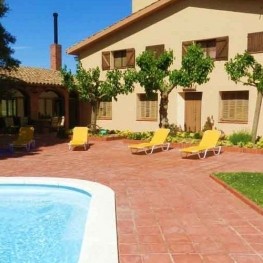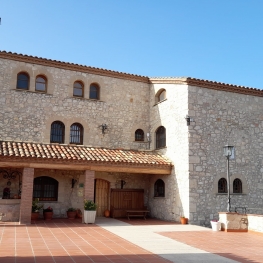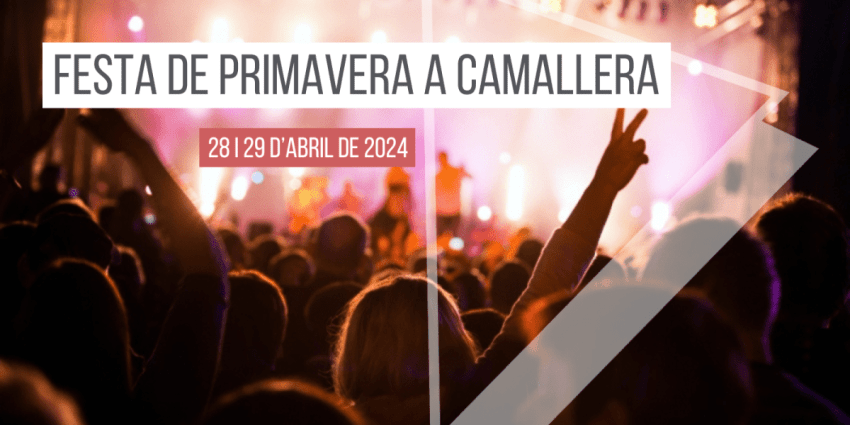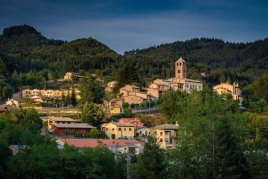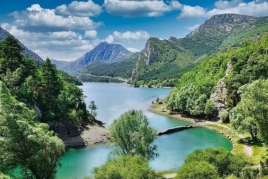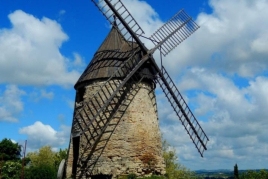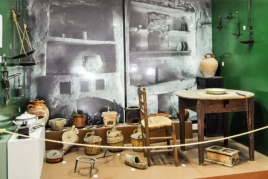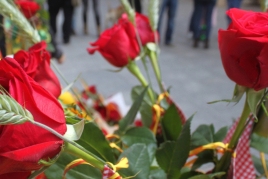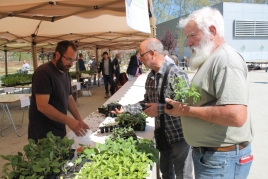From San Ramon to Cervera, crossing the southern Segarra
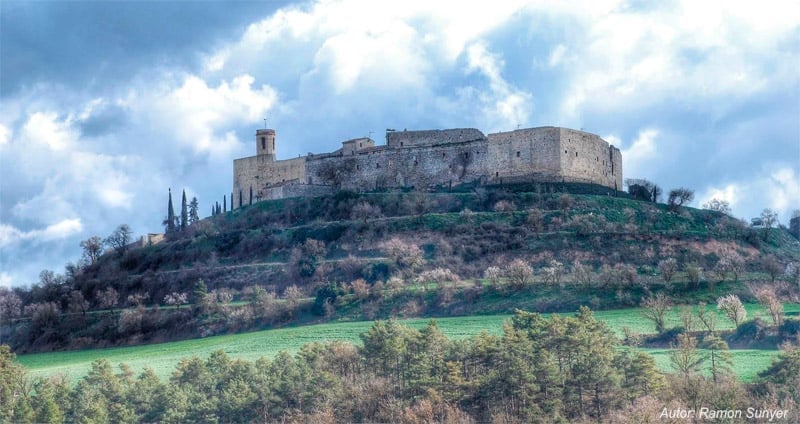
Halfway between the Central Catalonia and the Lleida we find the plateau of the Segarra, an area with a landscape marked by gentle slopes, with a stranglehold of the fields, and small stone villages, born around ancient castles.
On this route we will discover the landscape and some of the most significant places in the south of the region, the shrine of San Ramon, a place of religious devotion that stands dominant in the middle of La Segarra, Montfalcó, a curious example of the large number of fortifications extends throughout the territory and will end in the capital, Cervera, towering on a hill with numerous monuments that tell the history of the city and the country.
Sanctuary of San Ramon Nonato
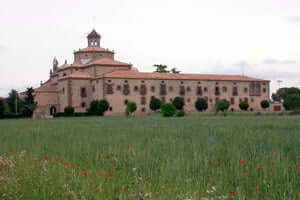 To start we went to the Sanctuary of San Ramon, we have to do to get through the transverse axis (C-25) and take exit 93 in San Ramon. The square and compact shape of the building has made is popularly called "El Escorial de la Segarra" a great religious building that includes the church, the old convent and cloister. The history of the sanctuary begins the year 1240 in the place where it is said that he was buried San Ramon Nonato, a saint with a nickname that refers to "unborn" because, according to legend, was extracted from the womb of his mother after she died.
To start we went to the Sanctuary of San Ramon, we have to do to get through the transverse axis (C-25) and take exit 93 in San Ramon. The square and compact shape of the building has made is popularly called "El Escorial de la Segarra" a great religious building that includes the church, the old convent and cloister. The history of the sanctuary begins the year 1240 in the place where it is said that he was buried San Ramon Nonato, a saint with a nickname that refers to "unborn" because, according to legend, was extracted from the womb of his mother after she died.
The main element is the church sanctuary, a large Baroque church where they emphasize the sculptural elements of the facade, the mausoleum of San Ramon Nonato or dome presiding cruise.
In the outbuildings to the church you can find a wide collection of votive offerings, gifts of gratitude to people who had entrusted to this saint, a fact that shows the great devotion that has generated over time. The votive tablets are a reflection of rural life in Catalonia since many of them are drawn accidents suffered by farmers in their work in the field. Finally, you must visit the cloister, a space neoclassical built in the nineteenth century.
Montfalcó
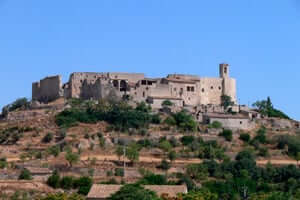 After this visit we headed one of the most curious places of La Segarra, Montfalcó village in the municipality of Les Oluges. To get there we must return to the C-25 and go towards Cervera and, soon, take exit 88 Les Oluges, once we are on the road to Les Oluges find the detour to Montfalcó. This core is a small walled city, despite being common these kinds of villas, in the case of Montfalcó the difference is that, despite being very small and located on top of a hill, the village did not grow beyond the walls and has been, until now, hidden inside a high rise walls. The first documents where there is evidence of the existence of Montfalcó date back to 1043, its fortified structure responds to that during the Middle Ages the village was near border between Christian and Muslim lands, an unstable area where were regular attacks and attempted invasion.
After this visit we headed one of the most curious places of La Segarra, Montfalcó village in the municipality of Les Oluges. To get there we must return to the C-25 and go towards Cervera and, soon, take exit 88 Les Oluges, once we are on the road to Les Oluges find the detour to Montfalcó. This core is a small walled city, despite being common these kinds of villas, in the case of Montfalcó the difference is that, despite being very small and located on top of a hill, the village did not grow beyond the walls and has been, until now, hidden inside a high rise walls. The first documents where there is evidence of the existence of Montfalcó date back to 1043, its fortified structure responds to that during the Middle Ages the village was near border between Christian and Muslim lands, an unstable area where were regular attacks and attempted invasion.
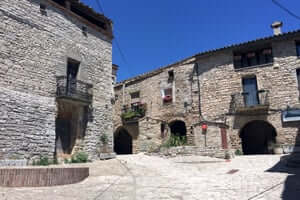 From outside the village practically only we see walls with few openings and a bell tower that stands out but if we stepped inside, we found a small medieval village. A single door allows us to reach inside the walls. Inside we found a circular street that runs all homes that were built terraced?? the wall, some parts are covered by houses that wanted to gain space covering the road, you can also see a porch with the old communal village bakery. This street round begins and ends in a central square in the basement of the square there is a large water cistern that allowed the people to be more self - sufficient; to fill the downspouts roofs were designed so that the rain water out to stop this great deposit. At one end of the core, at the end of a cul de sac, the church of San Pedro, a temple, in the apse, takes an old defense tower, belfry formerly also had the function of tower rises defending.
From outside the village practically only we see walls with few openings and a bell tower that stands out but if we stepped inside, we found a small medieval village. A single door allows us to reach inside the walls. Inside we found a circular street that runs all homes that were built terraced?? the wall, some parts are covered by houses that wanted to gain space covering the road, you can also see a porch with the old communal village bakery. This street round begins and ends in a central square in the basement of the square there is a large water cistern that allowed the people to be more self - sufficient; to fill the downspouts roofs were designed so that the rain water out to stop this great deposit. At one end of the core, at the end of a cul de sac, the church of San Pedro, a temple, in the apse, takes an old defense tower, belfry formerly also had the function of tower rises defending.
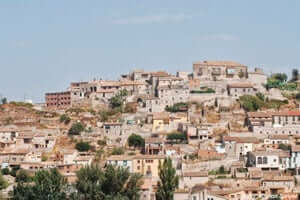 The airtight appearance of this small medieval town has been a source of legends which explains the long resistance Montfalcó during a siege, this resistance would have been possible thanks to a supposed underground tunnel that ran to the neighboring village of Les Oluges, from this step would have provided the supplies needed to continue resisting. The stories of the past are mixed with stone walls, arcades and narrow streets, elements that make Montfalcó a place where it seems time has stopped forever in the Middle Ages.
The airtight appearance of this small medieval town has been a source of legends which explains the long resistance Montfalcó during a siege, this resistance would have been possible thanks to a supposed underground tunnel that ran to the neighboring village of Les Oluges, from this step would have provided the supplies needed to continue resisting. The stories of the past are mixed with stone walls, arcades and narrow streets, elements that make Montfalcó a place where it seems time has stopped forever in the Middle Ages.
Cervera
If we leave the core Montfalcó and resumed the C-25 we will arrive to Cervera, capital of La Segarra. Cervera is a city full of history, we are next to the valley of the river Ondara, situated on a hill, a fact that has determined the shape of its streets and squares.
The church of Santa Maria
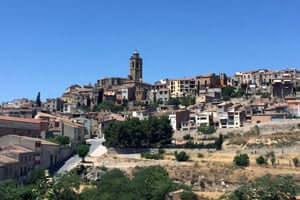 The old quarter of the city has a high concentration of historical heritage, it stands the church of Santa María, built between the fourteenth and fifteenth centuries, one of the most important religious buildings of Catalan Gothic architecture. The temple has its origins in an ancient Roman temple still a portal, iris, built in the Gothic building is preserved. Inside, consisting of three ships, some medieval stained glass partially preserved. Of all the interior elements highlight is the image of the Virgen del Coll of the Sabines, patron of the city, it is a beautiful Romanesque image dating from the thirteenth century. Inside the church we can also see examples of Baroque art that can be found in the chapel of the Blessed Mystery and San Andrés. The most emblematic element of the church is the bell tower icon Cervera. The bell tower remains, like the rest of the set, the typical lines of the Gothic style and was inspired by the steeple of the Old Cathedral of Lleida. Cervera still retains the office of ringer so that the festive touches of bells are made manually, without any mechanization. On certain days you can hear traditional touches made with the old sound of bells, although they were cast in the fifteenth and nineteenth centuries, they are still active.
The old quarter of the city has a high concentration of historical heritage, it stands the church of Santa María, built between the fourteenth and fifteenth centuries, one of the most important religious buildings of Catalan Gothic architecture. The temple has its origins in an ancient Roman temple still a portal, iris, built in the Gothic building is preserved. Inside, consisting of three ships, some medieval stained glass partially preserved. Of all the interior elements highlight is the image of the Virgen del Coll of the Sabines, patron of the city, it is a beautiful Romanesque image dating from the thirteenth century. Inside the church we can also see examples of Baroque art that can be found in the chapel of the Blessed Mystery and San Andrés. The most emblematic element of the church is the bell tower icon Cervera. The bell tower remains, like the rest of the set, the typical lines of the Gothic style and was inspired by the steeple of the Old Cathedral of Lleida. Cervera still retains the office of ringer so that the festive touches of bells are made manually, without any mechanization. On certain days you can hear traditional touches made with the old sound of bells, although they were cast in the fifteenth and nineteenth centuries, they are still active.
the Paeria
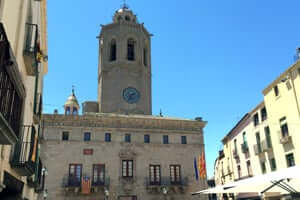 Stuck in the steeple of the church are the Paeria of Cervera, the traditional name is called the City of the villa. The building, completed in 1688 and expanded during the eighteenth century, presides over the main square and is one of the most original buildings of Catalan civil baroque. The highlight of the facades element is the corbels supporting the balconies, carved with characters representing different themes, the corbels of the balcony on the right represent characters in the market, the central balcony represent the five senses and left recreate characters related to the legal world. Inside you can find interesting elements such as ice well where snow collection was preserved during the winter to dispose of it in summer. The Paeria is the most important building in the Plaza Mayor, regularly hosts major festivals Cervera. The porticoed square is all because, originally, it was a place for discharging and sell the wheat that was grown around the porches were store all this grain.
Stuck in the steeple of the church are the Paeria of Cervera, the traditional name is called the City of the villa. The building, completed in 1688 and expanded during the eighteenth century, presides over the main square and is one of the most original buildings of Catalan civil baroque. The highlight of the facades element is the corbels supporting the balconies, carved with characters representing different themes, the corbels of the balcony on the right represent characters in the market, the central balcony represent the five senses and left recreate characters related to the legal world. Inside you can find interesting elements such as ice well where snow collection was preserved during the winter to dispose of it in summer. The Paeria is the most important building in the Plaza Mayor, regularly hosts major festivals Cervera. The porticoed square is all because, originally, it was a place for discharging and sell the wheat that was grown around the porches were store all this grain.
Main Street and the alley of the Witches
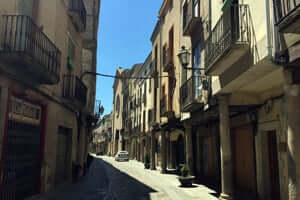 From the main square off the main street, vital artery of Cervera, a vial shows the evolution of the city and the moments of greatest splendor along its route we find buildings of historical significance and old mansions, has for centuries It has been the most important street of the town. One of the buildings marked by history is the complex of the Society of Jesus, located at 64, in 1351 the Catalan Parliament met and agreed there the creation of the Generalitat, it is also the place where the marriage contract is signed of the Catholic Kings, Ferdinand of Aragon and Isabella of Castile, in the nineteenth century, during his time as a college student welcomed as Jaume Balmes, philosopher and writer. On the same street, at number 61, we can find mansions and Cal Razquin, residence of Mr. de Pedrolo, relatives of the writer Manuel de Pedrolo, at number 89 the house Massot Dalmasses, at 92 the house Joan or the 115th house museum Duran and Sanpere, visitable inside. These houses, built at different times, reflect different times of the city and the wealth of some of their families. On the same street we can find other items of interest such as the ancient home of the Generalitat Delmera, at number 79, or the modernist cover of lime old barbershop Greoles, at number 105.
From the main square off the main street, vital artery of Cervera, a vial shows the evolution of the city and the moments of greatest splendor along its route we find buildings of historical significance and old mansions, has for centuries It has been the most important street of the town. One of the buildings marked by history is the complex of the Society of Jesus, located at 64, in 1351 the Catalan Parliament met and agreed there the creation of the Generalitat, it is also the place where the marriage contract is signed of the Catholic Kings, Ferdinand of Aragon and Isabella of Castile, in the nineteenth century, during his time as a college student welcomed as Jaume Balmes, philosopher and writer. On the same street, at number 61, we can find mansions and Cal Razquin, residence of Mr. de Pedrolo, relatives of the writer Manuel de Pedrolo, at number 89 the house Massot Dalmasses, at 92 the house Joan or the 115th house museum Duran and Sanpere, visitable inside. These houses, built at different times, reflect different times of the city and the wealth of some of their families. On the same street we can find other items of interest such as the ancient home of the Generalitat Delmera, at number 79, or the modernist cover of lime old barbershop Greoles, at number 105.
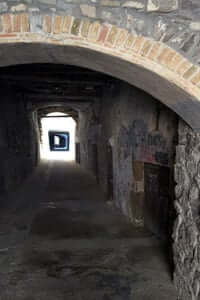 Parallel to the main street is the alley of the Witches. We can reach it from the detour we found at number 60 on the same street. Local legends identify this place as the place where witches gathered the full moon night. The street is largely cover. The porches that cover its narrowness and give this place a dark and mysterious, suitable to imagine stories of witchcraft aspect. To enhance this environment a few years ago were placed along its route several esoteric figures, some elements related party Coven, this popular celebration of esoteric topic is held every August in Cervera and was born precisely on this street.
Parallel to the main street is the alley of the Witches. We can reach it from the detour we found at number 60 on the same street. Local legends identify this place as the place where witches gathered the full moon night. The street is largely cover. The porches that cover its narrowness and give this place a dark and mysterious, suitable to imagine stories of witchcraft aspect. To enhance this environment a few years ago were placed along its route several esoteric figures, some elements related party Coven, this popular celebration of esoteric topic is held every August in Cervera and was born precisely on this street.
If we return to the main street and came to an end, we reach the Plaza de Santa Ana, from there we can access Street Barbacana passing over the walls of Cervera, built the fourteenth and fifteenth centuries, covering the lower part of the old town.
University
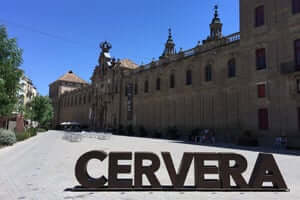 To end the visit to Cervera, we drive to the University building, important for its historical, artistic significance and also for its wide dimensions. Cervera University has its origins in the eighteenth century when the city showed their loyalty to Philip V, the first king of the dynasty in Spain and winner of the War of Succession to the Spanish crown. In a Catalonia that was mostly made for Charles of Austria, the other candidate to be king, Philip V wanted to reward positioning his favor he had done Cervera, making it the headquarters of the Central University of Catalonia and deleting the rest Catalan universities. The University of Cervera starts in 1717 but, years later, is losing gradually its centrality until 1842 was finally moved to Barcelona.
To end the visit to Cervera, we drive to the University building, important for its historical, artistic significance and also for its wide dimensions. Cervera University has its origins in the eighteenth century when the city showed their loyalty to Philip V, the first king of the dynasty in Spain and winner of the War of Succession to the Spanish crown. In a Catalonia that was mostly made for Charles of Austria, the other candidate to be king, Philip V wanted to reward positioning his favor he had done Cervera, making it the headquarters of the Central University of Catalonia and deleting the rest Catalan universities. The University of Cervera starts in 1717 but, years later, is losing gradually its centrality until 1842 was finally moved to Barcelona.
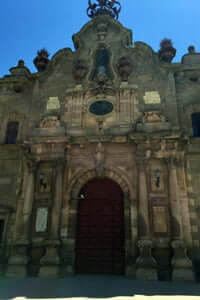 The University of Cervera arrived to take up to two thousand students and changed the daily life of the population. The imposing baroque building that housed highlights decorating your master with the figure of the Immaculate Conception, patroness of the University, and the crown at the top portal element that highlights the real origin of the institution. The building has a ground floor and first floor inside the enclosure is structured around a courtyard entrance and two cloisters. The most important part is the assembly hall, formerly used for academic and religious events, presides over the altarpiece space dedicated to the Immaculate, built with marble and alabaster.
The University of Cervera arrived to take up to two thousand students and changed the daily life of the population. The imposing baroque building that housed highlights decorating your master with the figure of the Immaculate Conception, patroness of the University, and the crown at the top portal element that highlights the real origin of the institution. The building has a ground floor and first floor inside the enclosure is structured around a courtyard entrance and two cloisters. The most important part is the assembly hall, formerly used for academic and religious events, presides over the altarpiece space dedicated to the Immaculate, built with marble and alabaster.
If we make a return to the entire building we can get an idea of the dimensions that occupies this building more than one hectare. On the back is the Paseo Balmes, at the end of this ride will find a viewpoint from where the old core is observed Cervera and also a broad view of the countryside of La Segarra, with its geography gently undulating dominated fields cereals, green in spring, golden in summer.
What to do
La Passió de Cervera
CerveraThe Passion of Cervera is a theatrical representation of life, death and…
Memorial de l'Exèrcit popular
Pujalt (a 4.9 Km)The Popular Army Memorial Pujalt invites you to know the history of…
Mas de Colom, Casa Borges
Tàrrega (a 12.5 Km)The old convent and farmhouse are located on the Mas de Colom…
Reial Monestir de Santa Maria de Vallbona
Vallbona de les Monges (a 22.4 Km)An extraordinary space in which the passage of time is shared with…
Where to eat
Hostal de Pinós
Pinós (a 18.6 Km)The Hostal de Pinos is located at the geographic center of Catalonia…
Where to sleep
Hotel Balneari de Vallfogona de Riucorb
Vallfogona de Riucorb (a 12 Km)Enjoy the Hotel Balneario de Vallfogona de Riucorb, which has modern facilities…
Masia Cal Mestre
Sant Martí de Tous (a 21.7 Km)Masia Cal Mestre is a completely renovated 18th century house in Central…
Mas Baldrich / Petit Mas Baldrich
Querol (a 28 Km)Mas Baldrich is a typical Catalan farmhouse built during the 19th century,…

